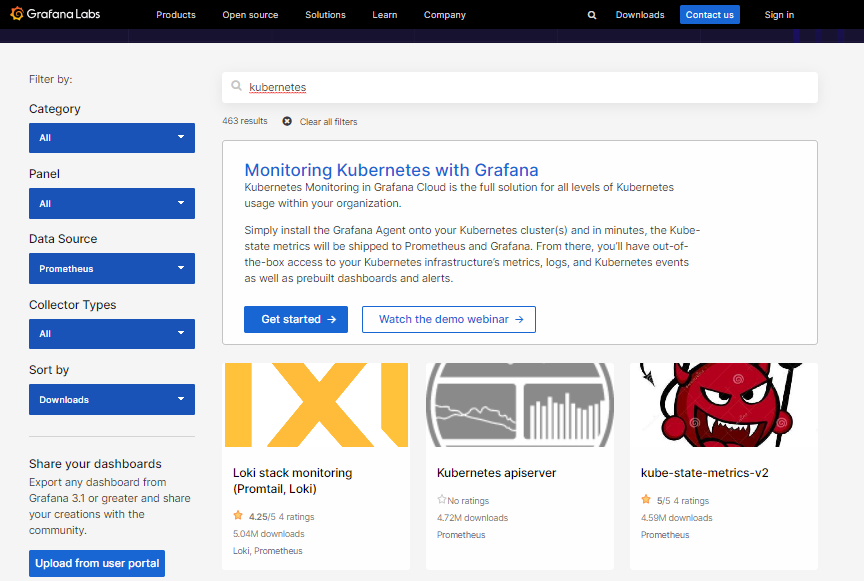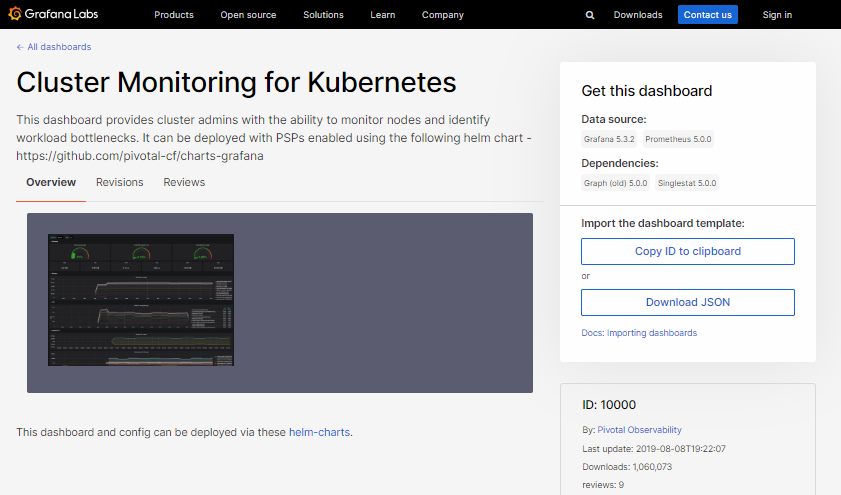All-Things-Docker-and-Kubernetes
Lab 059 - Deploy Prometheus and Grafana using Helm
- Pre-requisites
- Introduction
- Launch an EKS Cluster
- Create the Persistent Storage
- Create the Namespace
- Setup Prometheus
- Setup Grafana
- Importing a Public Dashboard
- Troubleshooting
- Resources
Pre-requisites
- Basic Understanding of Kubernetes
- AWS account
- AWS IAM Requirements
- AWS CLI, kubectl, and eksct installed
Introduction
Prometheus serves as a system monitor which allows us the ability to analyze what’s happening to our system resources at any given time. Within a Kubernetes environment, it is possible to expose the metrics/ endpoint, allowing Prometheus to fetch metrics from said endpoint.
Grafana serves as a tool for visualizing data in user-friendly and easily understandable dashboards. While it is possible to view data directly in Prometheus, the data becomes more readily interpretable and actionable when monitored through Grafana’s dashboards.
The combinatiopn of these two tools can be used to manage workload outside Kubernetes clusters but they also work well with containerized applications.
A few notes:
- This lab will use Helm to setup both tools
- The EKS cluster and EFS filesystem will also be created
- The necessary YAML files are in the manifests directory
Launch an EKS Cluster
Before we setup the cluster, ensure that we have the correct IAM user’s access keys. This should be the user created from the pre-requisites section above.
aws sts get-caller-identity
{
"UserId": "AIDxxxxxxxxxxxxxx",
"Account": "1234567890",
"Arn": "arn:aws:iam::1234567890:user/k8s-admin"
}
For the cluster, we can reuse the eksops.yml file from the previous labs. Launch the cluster. Note that you must have generated an SSH key pair which can be used to SSH onto the nodes. The keypair I’ve used here is named “k8s-kp” and is specified in the manifest file.
time eksctl create cluster -f manifests/eksops.yml
Check the nodes.
kubectl get nodes
Save the cluster, region, and AWS account ID in a variable. We’ll be using these in a lot of the commands later.
MYREGION=ap-southeast-1
MYCLUSTER=eksops
MYAWSID=$(aws sts get-caller-identity | python3 -c "import sys,json; print (json.load(sys.stdin)['Account'])")
Verify in the AWS Management Console. We should be able to see the cluster and the nodegroup.
Create the Persistent Storage
I’ve found that most tutorials/resources online go straight into deploying the Prometheus and Grafana without mentioning that each Prometheus instance will need a persistent volume (PV) to store the recorded metrics. When we deploy Prometheus without setting up the persistent storage first, we’ll have two of the Prometheus pods stuck in Pending state.
$ kubectl get pods -n prometheus | grep Pending
pod/prometheus-alertmanager-0 0/1 Pending 0 23s
pod/prometheus-server-6799c8f885-8b8fh 0/2 Pending 0 23s
Since we’re using an Amazon EKS cluster, then the available persistent storage that we can use are:
- EBS
- EFS
A basic Prometheus setup can work with an EBS volume for persisting the data but in the event that the EC2 instance goes down or we need to scale up the number of Prometheus servers, the EBS volume can only be accessed by instances launched in the same availability zone. This is because EBS volumes are zone specific and in addition to this, cannot be shared across multiple instances.
On the other hand, an EFS Filesystem allows to mount the same storage across availability zones and can be accessed by multiple instances at the same time.
Using EFS as Prometheus storage
NOTE: As of June 2023, Prometheus still doesn’t work with NFS, especially EFS. More details can be found here: https://prometheus.io/docs/prometheus/latest/storage/
There are some sources online that mentioned that they were able to make it work succesfully since Prometheus storage is now omptimized so well that it has little I/O strain. However, these sources did not provide any supporting links or instructions on how to implement EFS as the Prometheus storage.
I’m hesitant to remove my notes on my attempt to use EFS so I’ll just leave it here in case there will be a support for EFS in the distant future.
Using EFS as Prometheus storage (Unsuccessful)
~~We'll be using an EFS Filesystem for this lab~~. The detailed steps are provided in the [previous Lab](/All-Things-Docker-and-Kubernetes/projects/Lab_058_EKS_Deploy_a_Stateful_App_using_EFS_OUTDATED/). Here's the summary: ```bash ### Verify that you an OIDC provider created. aws eks describe-cluster --name $MYCLUSTER --query "cluster.identity.oidc.issuer" --output text ### Create the IAM Policy and role. aws iam create-policy \ --policy-name AmazonEKS_EFS_CSI_Driver_Policy \ --policy-document file://iam_policies/iam-policy.json aws iam create-role \ --role-name AmazonEKS_EFS_CSI_DriverRole \ --assume-role-policy-document file://"iam_policies/trust-policy.json" aws iam attach-role-policy \ --policy-arn arn:aws:iam::$MYAWSID:policy/AmazonEKS_EFS_CSI_Driver_Policy \ --role-name AmazonEKS_EFS_CSI_DriverRole ### Create the service account. kubectl apply -f manifests/efs-service-account.yml ### Install the EFS Driver helm repo add aws-efs-csi-driver https://kubernetes-sigs.github.io/aws-efs-csi-driver/ helm repo update helm upgrade -i aws-efs-csi-driver aws-efs-csi-driver/aws-efs-csi-driver \ --namespace kube-system \ --set image.repository=602401143452.dkr.ecr.ap-southeast-1.amazonaws.com/eks/aws-efs-csi-driver \ --set controller.serviceAccount.create=false \ --set controller.serviceAccount.name=efs-csi-controller-sa kubectl get pod -n kube-system -l "app.kubernetes.io/name=aws-efs-csi-driver,app.kubernetes.io/instance=aws-efs-csi-driver" ``` Next, create the EFS Filesystem. Since the console UI is changing from time to time, better to follow the [official AWS Documentation](https://docs.aws.amazon.com/efs/latest/ug/creating-using-create-fs.html) on how to create the EFS Filesystem.  Next, create the access point by selecting the EFS filesystem and clicking the **Access Points** tab at the bottom. Click **Create access point** to create two access points: Fields | Values | ---------|----------| Filesystem | Select the filesystem you just created | Name | Prometheus Server | Root | /prometheus/server | Posix User ID | 500 | Posix Group ID | 500 | Root directory creation permissions User ID | 500 | Root directory creation permissions Group ID | 500 | Access point permissions | 0755 | Fields | Values | ---------|----------| Filesystem | Select the filesystem you just created | Name | Prometheus Alert Manager | Root | /prometheus/alertmanager | Posix User ID | 501 | Posix Group ID | 501 | Root directory creation permissions User ID | 501 | Root directory creation permissions Group ID | 501 | Access point permissions | 0755 | Both access points should be in the "Available" state. Take note of the Access Point ID of each.  Once we have the EFS driver and EFS Filesystem set up, the next step is to create the persistent volumes. We can use the [storageclass-pvc.yml](/All-Things-Docker-and-Kubernetes/projects/Lab_059_EKS_Deploy_Prometheus_and_Grafana_using_Helm/manifests/storageclass-pvc.yml). Make sure to edit the YAML file first and replace the **volumeHandle** with the correct *fsap* (access point) ID. ```bash volumeHandle: "fs-05f10ff5687745db0::fsap-014801081296c0219" ``` ```bash kubectl apply -f manifests/storageclass-pvc.yml ```
Using EBS as Prometheus storage
The detailed steps to install the EBS CSI provisioner can be found in the previous Lab 057.. Here’s the summary:
MYREGION=ap-southeast-1 # Specify the region here
MYCLUSTER=eksops # Specify the cluster name here
MYAWSID=$(aws sts get-caller-identity | python3 -c "import sys,json; print (json.load(sys.stdin)['Account'])")
aws eks describe-cluster \
--name $MYCLUSTER \
--region $MYREGION \
--query "cluster.identity.oidc.issuer" --output text
If the describe command did not return anything, you will need to create the OIDC provider.
Create an IAM Policy and IAM role, and then attach the policy to the role.
aws iam create-policy \
--policy-name AmazonEKS_EBS_CSI_Driver_Policy \
--policy-document file://manifests/example-iam-policy.json
aws iam create-role \
--role-name AmazonEKS_EBS_CSI_DriverRole \
--assume-role-policy-document file://"trust-policy.json"
aws iam attach-role-policy \
--policy-arn arn:aws:iam::$MYAWSID:policy/AmazonEKS_EBS_CSI_Driver_Policy \
--role-name AmazonEKS_EBS_CSI_DriverRole
To deploy the Amazon EBS CSI driver:
If you’re based in a non-China region, run:
kubectl apply -k "github.com/kubernetes-sigs/aws-ebs-csi-driver/deploy/kubernetes/overlays/stable/?ref=master"
If you’re based in a China region, run:
kubectl apply -k "github.com/kubernetes-sigs/aws-ebs-csi-driver/deploy/kubernetes/overlays/stable-cn/?ref=master"
The steps above will create a few resources, including the service account ebs-csi-controller-sa. Annotate the Kubernetes service account with the Amazon Resource Name (ARN) of the IAM role.
kubectl annotate serviceaccount ebs-csi-controller-sa \
-n kube-system \
eks.amazonaws.com/role-arn=arn:aws:iam::$MYAWSID:role/AmazonEKS_EBS_CSI_DriverRole
Create the Namespace
As Kubernetes best pratice, create the namespace for each. Use the namespace.yml
kubectl apply -f manifests/namespace.yml
Setup Prometheus
Install the prometheus using Helm.
helm repo add prometheus-community https://prometheus-community.github.io/helm-charts
helm install prometheus prometheus-community/prometheus \
--namespace prometheus \
--set alertmanager.persistentVolume.storageClass="ebs-sc" \
--set server.persistentVolume.storageClass="ebs-sc"
Take note of the endpoint that will be shown in the output.
The Prometheus PushGateway can be accessed via port 9091 on the following DNS name from within your cluster:
prometheus-prometheus-pushgateway.prometheus.svc.cluster.local
Check if Prometheus is deployed.
$ kubectl get all -n prometheus
NAME READY STATUS RESTARTS AGE
pod/prometheus-alertmanager-0 0/1 Pending 0 23s
pod/prometheus-kube-state-metrics-6fcf5978bf-h6m4l 1/1 Running 0 23s
pod/prometheus-prometheus-node-exporter-8ck4p 1/1 Running 0 23s
pod/prometheus-prometheus-node-exporter-scc7f 1/1 Running 0 24s
pod/prometheus-prometheus-node-exporter-w2p5d 1/1 Running 0 23s
pod/prometheus-prometheus-pushgateway-fdb75d75f-9twn8 1/1 Running 0 23s
pod/prometheus-server-6799c8f885-8b8fh 0/2 Pending 0 23s
NAME TYPE CLUSTER-IP EXTERNAL-IP PORT(S) AGE
service/prometheus-alertmanager ClusterIP 10.100.200.40 <none> 9093/TCP 24s
service/prometheus-alertmanager-headless ClusterIP None <none> 9093/TCP 24s
service/prometheus-kube-state-metrics ClusterIP 10.100.243.162 <none> 8080/TCP 24s
service/prometheus-prometheus-node-exporter ClusterIP 10.100.62.33 <none> 9100/TCP 24s
service/prometheus-prometheus-pushgateway ClusterIP 10.100.47.210 <none> 9091/TCP 24s
service/prometheus-server ClusterIP 10.100.238.155 <none> 80/TCP 24s
NAME DESIRED CURRENT READY UP-TO-DATE AVAILABLE NODE SELECTOR AGE
daemonset.apps/prometheus-prometheus-node-exporter 3 3 3 3 3 <none> 25s
NAME READY UP-TO-DATE AVAILABLE AGE
deployment.apps/prometheus-kube-state-metrics 1/1 1 1 26s
deployment.apps/prometheus-prometheus-pushgateway 1/1 1 1 26s
deployment.apps/prometheus-server 0/1 1 0 26s
NAME DESIRED CURRENT READY AGE
replicaset.apps/prometheus-kube-state-metrics-6fcf5978bf 1 1 1 26s
replicaset.apps/prometheus-prometheus-pushgateway-fdb75d75f 1 1 1 26s
replicaset.apps/prometheus-server-6799c8f885 1 1 0 26s
NAME READY AGE
statefulset.apps/prometheus-alertmanager 0/1 26s
To access the Prometheus in our local workstation, get the pod name and forward the traffic to a local port.
export POD_NAME=$(kubectl get pods --namespace prometheus -l "app=prometheus-pushgateway,component=pushgateway" -o jsonpath="{.items[0].metadata.name}")
kubectl --namespace prometheus port-forward $POD_NAME 9093
Open a web browser and specify the URL to access the Prometheus UI.
Perform a sample query. Click the dropdown menu and select kubectl_node_info and then click Execute. The nodes infromation will appear below.
Setup Grafana
Use grafana.yml to setup Grafana. Make sure to replace the url with the Prometheus endpoint from the previous step.
helm install grafana grafana/grafana \
--namespace grafana \
--set persistence.storageClassName="efs-sc" \
--set persistence.enabled=true \
--set adminPassword='grafanaadmin' \
--values manifests/grafana.yaml \
--set service.type=LoadBalancer
Check the resources.
kubectl get all -n grafana
Retrive the username and password.
kubectl get secret --namespace grafana grafana -o jsonpath="{.data.admin-password}" | base64 --decode ; echo
Get the Grafana ELB URL and paste it into the browser to access the Grafana web UI.
export ELB=$(kubectl get svc -n grafana grafana -o jsonpath='{.status.loadBalancer.ingress[0].hostname}')
echo "http://$ELB"
Login using the username admin the password retrieved from the previous step.
On the left panel, click the gear icon, click Configuration > Data Sources. Here we can see that it’s using the Prometheus as a data source.
Importing a Public Dashboard
Go to the Grafana website to access the catalog of pre-configured dashboards.
https://grafana.com/grafana/dashboards/
In the Filter by section, click the Data Source dropdown bar and select Prometheus.. In the search bar, type “Kubernetes”. This will display all the available dashboards.

We’ll use Cluster Monitoring for Kubernetes for this lab.

Troubleshooting
Removing Prometheus
If you encountered some issues and you need to delete the Prometheus pod, simply run the following commands. Note that the list command may
helm list -n prometheus
helm uninstall prometheus -n prometheus
Prometheus stuck in Pending
You might find that two pods are stuck in Pending state
NAME READY STATUS RESTARTS AGE
prometheus-alertmanager-7757d759b8-x6bd7 0/2 Pending 0 44m
prometheus-kube-state-metrics-7f85b5d86c-cq9kr 1/1 Running 0 44m
prometheus-node-exporter-5rz2k 1/1 Running 0 44m
prometheus-pushgateway-5b8465d455-672d2 1/1 Running 0 44m
prometheus-server-7f8b5fc64b-w626v 0/2 Pending 0 44m
If you have older installations, you will need to remove them. Check for other instances of Prometheus.
kubectl get pods --all-namespaces --selector=app.kubernetes.io/name=prometheus
Prometheus pods will need to bind to a volume so confirm that you have created a persistent volume before deploying the chart, otherwise it will stay in Pending.
Prometheus will try to create PersiatentVolumeClaims with accessModes as ReadWriteOnce, PVC will get matched to PersistentVolume only if accessmodes are same. Change your accessmode of PV to ReadWriteOnce.
Resources
Prometheus:
- https://ngoyal16.medium.com/how-we-setup-prometheus-multi-az-persistent-storage-b6601fd1171a
- https://www.prometheusbook.com/
- https://prometheus.io/docs/introduction/overview/
- https://catalog.workshops.aws/running-batch-on-eks/en-US/exercises/calculate-pi/setup-prometheus-grafana
- https://medium.com/devops-dudes/install-prometheus-on-ubuntu-18-04-a51602c6256b
Prometheus not supporting EFS:
- https://github.com/prometheus-operator/prometheus-operator/issues/4631
- https://github.com/prometheus-operator/prometheus-operator/issues/3150
- https://prometheus.io/docs/prometheus/latest/storage/
- https://stackoverflow.com/questions/58106982/prometheus-and-nfs-storage
- https://www.reddit.com/r/sysadmin/comments/10k9tsq/prometheus_vs_efs_i_dont_know_who_to_believe/